阅读理解专题③——猜测词义(教师版)
- 格式:doc
- 大小:90.50 KB
- 文档页数:6
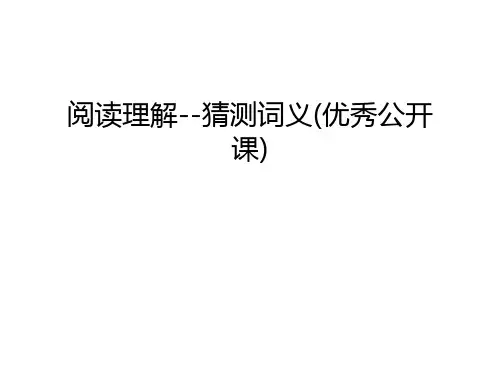
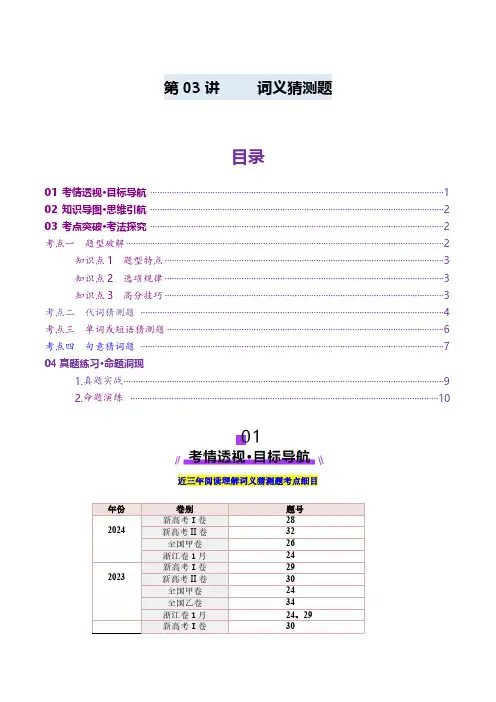
第03讲词义猜测题目录01 考情透视·目标导航∙∙∙∙∙∙∙∙∙∙∙∙∙∙∙∙∙∙∙∙∙∙∙∙∙∙∙∙∙∙∙∙∙∙∙∙∙∙∙∙∙∙∙∙∙∙∙∙∙∙∙∙∙∙∙∙∙∙∙∙∙∙∙∙∙∙∙∙∙∙∙∙∙∙∙∙∙∙∙∙∙∙∙∙∙∙∙∙∙∙∙∙∙∙∙∙∙∙∙∙∙∙∙∙∙∙∙∙∙∙∙∙∙∙∙∙∙∙∙∙∙∙102 知识导图·思维引航∙∙∙∙∙∙∙∙∙∙∙∙∙∙∙∙∙∙∙∙∙∙∙∙∙∙∙∙∙∙∙∙∙∙∙∙∙∙∙∙∙∙∙∙∙∙∙∙∙∙∙∙∙∙∙∙∙∙∙∙∙∙∙∙∙∙∙∙∙∙∙∙∙∙∙∙∙∙∙∙∙∙∙∙∙∙∙∙∙∙∙∙∙∙∙∙∙∙∙∙∙∙∙∙∙∙∙∙∙∙∙∙∙∙∙∙∙∙∙∙∙∙203 考点突破·考法探究∙∙∙∙∙∙∙∙∙∙∙∙∙∙∙∙∙∙∙∙∙∙∙∙∙∙∙∙∙∙∙∙∙∙∙∙∙∙∙∙∙∙∙∙∙∙∙∙∙∙∙∙∙∙∙∙∙∙∙∙∙∙∙∙∙∙∙∙∙∙∙∙∙∙∙∙∙∙∙∙∙∙∙∙∙∙∙∙∙∙∙∙∙∙∙∙∙∙∙∙∙∙∙∙∙∙∙∙∙∙∙∙∙∙∙∙∙∙∙∙∙∙2考点一题型破解∙∙∙∙∙∙∙∙∙∙∙∙∙∙∙∙∙∙∙∙∙∙∙∙∙∙∙∙∙∙∙∙∙∙∙∙∙∙∙∙∙∙∙∙∙∙∙∙∙∙∙∙∙∙∙∙∙∙∙∙∙∙∙∙∙∙∙∙∙∙∙∙∙∙∙∙∙∙∙∙∙∙∙∙∙∙∙∙∙∙∙∙∙∙∙∙∙∙∙∙∙∙∙∙∙∙∙∙∙∙∙∙∙∙∙∙∙∙∙∙∙∙∙∙∙∙∙∙∙∙∙∙2知识点1 题型特点∙∙∙∙∙∙∙∙∙∙∙∙∙∙∙∙∙∙∙∙∙∙∙∙∙∙∙∙∙∙∙∙∙∙∙∙∙∙∙∙∙∙∙∙∙∙∙∙∙∙∙∙∙∙∙∙∙∙∙∙∙∙∙∙∙∙∙∙∙∙∙∙∙∙∙∙∙∙∙∙∙∙∙∙∙∙∙∙∙∙∙∙∙∙∙∙∙∙∙∙∙∙∙∙∙∙∙∙∙∙∙∙∙∙∙∙3知识点2 选项规律∙∙∙∙∙∙∙∙∙∙∙∙∙∙∙∙∙∙∙∙∙∙∙∙∙∙∙∙∙∙∙∙∙∙∙∙∙∙∙∙∙∙∙∙∙∙∙∙∙∙∙∙∙∙∙∙∙∙∙∙∙∙∙∙∙∙∙∙∙∙∙∙∙∙∙∙∙∙∙∙∙∙∙∙∙∙∙∙∙∙∙∙∙∙∙∙∙∙∙∙∙∙∙∙∙∙∙∙∙∙∙∙∙∙∙∙3知识点3 高分技巧∙∙∙∙∙∙∙∙∙∙∙∙∙∙∙∙∙∙∙∙∙∙∙∙∙∙∙∙∙∙∙∙∙∙∙∙∙∙∙∙∙∙∙∙∙∙∙∙∙∙∙∙∙∙∙∙∙∙∙∙∙∙∙∙∙∙∙∙∙∙∙∙∙∙∙∙∙∙∙∙∙∙∙∙∙∙∙∙∙∙∙∙∙∙∙∙∙∙∙∙∙∙∙∙∙∙∙∙∙∙∙∙∙∙∙∙3考点二代词猜测题∙∙∙∙∙∙∙∙∙∙∙∙∙∙∙∙∙∙∙∙∙∙∙∙∙∙∙∙∙∙∙∙∙∙∙∙∙∙∙∙∙∙∙∙∙∙∙∙∙∙∙∙∙∙∙∙∙∙∙∙∙∙∙∙∙∙∙∙∙∙∙∙∙∙∙∙∙∙∙∙∙∙∙∙∙∙∙∙∙∙∙∙∙∙∙∙∙∙∙∙∙∙∙∙∙∙∙∙∙∙∙∙∙∙∙∙∙∙∙∙∙∙∙∙∙∙4考点三单词或短语猜测题∙∙∙∙∙∙∙∙∙∙∙∙∙∙∙∙∙∙∙∙∙∙∙∙∙∙∙∙∙∙∙∙∙∙∙∙∙∙∙∙∙∙∙∙∙∙∙∙∙∙∙∙∙∙∙∙∙∙∙∙∙∙∙∙∙∙∙∙∙∙∙∙∙∙∙∙∙∙∙∙∙∙∙∙∙∙∙∙∙∙∙∙∙∙∙∙∙∙∙∙∙∙∙∙∙∙∙∙∙∙∙∙∙∙∙6考点四句意猜词题∙∙∙∙∙∙∙∙∙∙∙∙∙∙∙∙∙∙∙∙∙∙∙∙∙∙∙∙∙∙∙∙∙∙∙∙∙∙∙∙∙∙∙∙∙∙∙∙∙∙∙∙∙∙∙∙∙∙∙∙∙∙∙∙∙∙∙∙∙∙∙∙∙∙∙∙∙∙∙∙∙∙∙∙∙∙∙∙∙∙∙∙∙∙∙∙∙∙∙∙∙∙∙∙∙∙∙∙∙∙∙∙∙∙∙∙∙∙∙∙∙∙∙∙∙∙7 04真题练习·命题洞现1.真题实战∙∙∙∙∙∙∙∙∙∙∙∙∙∙∙∙∙∙∙∙∙∙∙∙∙∙∙∙∙∙∙∙∙∙∙∙∙∙∙∙∙∙∙∙∙∙∙∙∙∙∙∙∙∙∙∙∙∙∙∙∙∙∙∙∙∙∙∙∙∙∙∙∙∙∙∙∙∙∙∙∙∙∙∙∙∙∙∙∙∙∙∙∙∙∙∙∙∙∙∙∙∙∙∙∙∙∙∙∙∙∙∙∙∙∙∙∙∙∙∙∙∙∙∙∙∙∙∙∙∙∙∙∙92.命题演练∙∙∙∙∙∙∙∙∙∙∙∙∙∙∙∙∙∙∙∙∙∙∙∙∙∙∙∙∙∙∙∙∙∙∙∙∙∙∙∙∙∙∙∙∙∙∙∙∙∙∙∙∙∙∙∙∙∙∙∙∙∙∙∙∙∙∙∙∙∙∙∙∙∙∙∙∙∙∙∙∙∙∙∙∙∙∙∙∙∙∙∙∙∙∙∙∙∙∙∙∙∙∙∙∙∙∙∙∙∙∙∙∙∙∙∙∙∙∙∙∙∙∙∙∙∙∙∙10近三年阅读理解词义猜测题考点细目考点一题型破解知识点1 题型特点分析近三年新高考卷及全国卷考查词义猜词的题目可知,对短语的考查与对生词的考查都有所涉及,短语已经不再限制于由课标词组成的短语了,出现了非课标词。
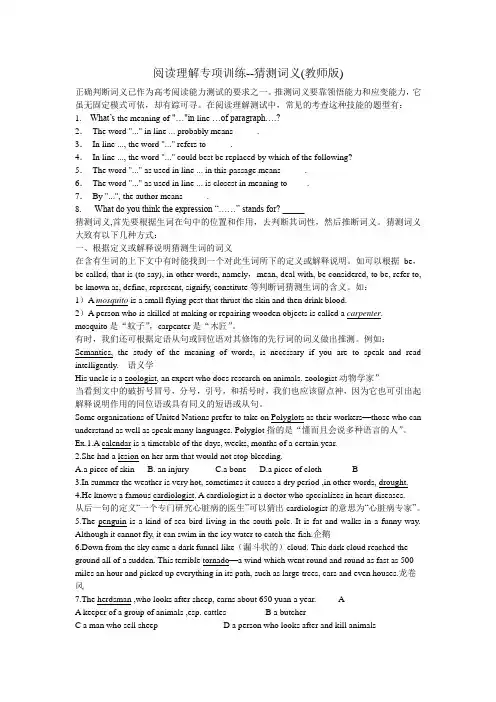
阅读理解专项训练--猜测词义(教师版)正确判断词义已作为高考阅读能力测试的要求之一。
推测词义要靠领悟能力和应变能力,它虽无固定模式可依,却有踪可寻。
在阅读理解测试中,常见的考查这种技能的题型有:1. What’s the meaning of "…"in line …of paragraph….?2.The word "..." in line ... probably means _____.3.In line ..., the word "..." refers to _____.4.In line ..., the word "..." could best be replaced by which of the following?5.The word "..." as used in line ... in this passage means _____.6.The word "..." as used in line ... is closest in meaning to ____.7.By "...", the author means _____.8. What do you think the expression “……” stands for? _____猜测词义,首先要根据生词在句中的位置和作用,去判断其词性,然后推断词义。
猜测词义大致有以下几种方式:一、根据定义或解释说明猜测生词的词义在含有生词的上下文中有时能找到一个对此生词所下的定义或解释说明。
如可以根据be,be called, that is (to say), in other words,namely,mean, deal with, be considered, to be, refer to, be known as, define, represent, signify, constitute等判断词猜测生词的含义。
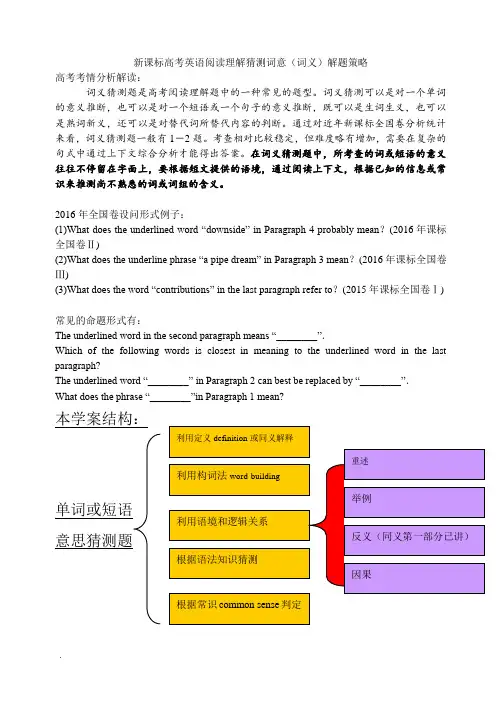
新课标高考英语阅读理解猜测词意(词义)解题策略高考考情分析解读:词义猜测题是高考阅读理解题中的一种常见的题型。
词义猜测可以是对一个单词的意义推断,也可以是对一个短语或一个句子的意义推断,既可以是生词生义,也可以是熟词新义,还可以是对替代词所替代内容的判断。
通过对近年新课标全国卷分析统计来看,词义猜测题一般有1-2题。
考查相对比较稳定,但难度略有增加,需要在复杂的句式中通过上下文综合分析才能得出答案。
在词义猜测题中,所考查的词或短语的意义往往不停留在字面上,要根据短文提供的语境,通过阅读上下文,根据已知的信息或常识来推测尚不熟悉的词或词组的含义。
2016年全国卷设问形式例子:(1)What does the underlined word “downside” in Paragraph 4 probably mean?(2016年课标全国卷Ⅱ)(2)What does the underline phrase “a pipe dream” in Paragraph 3 mean?(2016年课标全国卷Ⅲ)(3)What does the word “contributions” in the la st paragraph refer to?(2015年课标全国卷Ⅰ)常见的命题形式有:The underlined word in the second paragraph means “________”.Which of the following words is closest in meaning to the underlined word in the last paragraph?The underlined word “________” in Paragraph 2 can best be replaced by “________”.What does the phrase “________”in Paragraph 1 mean?本学案结构:代词指代猜测题目句子猜测句意题目附:典故谚语知识储备单词或短语意思猜测题该题型着重考查考生根据上下文猜测词义的能力,这也是一个从“已知”得出“未知”的过程,即利用上下文的已知部分(尤其是该词或短语前后的句子)进行推理,有时还需要依靠常识和经验来猜测词义。
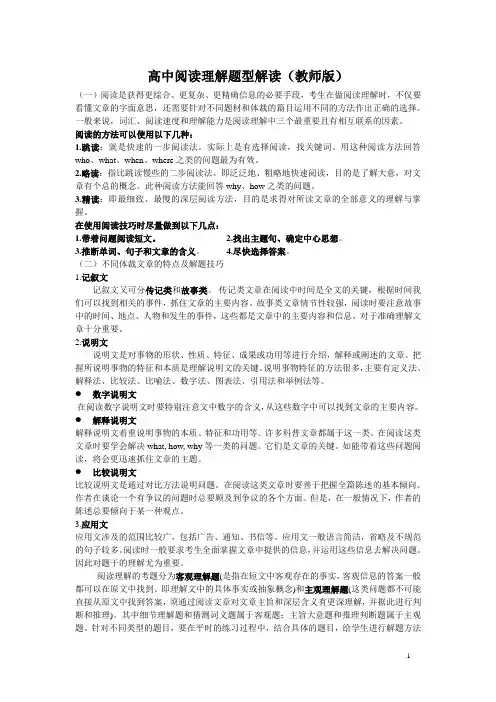
高中阅读理解题型解读(教师版)(一)阅读是获得更综合、更复杂、更精确信息的必要手段,考生在做阅读理解时,不仅要看懂文章的字面意思,还需要针对不同题材和体裁的篇目运用不同的方法作出正确的选择。
一般来说,词汇、阅读速度和理解能力是阅读理解中三个最重要且有相互联系的因素。
阅读的方法可以使用以下几种:1.跳读:就是快速的一步阅读法。
实际上是有选择阅读,找关键词。
用这种阅读方法回答who、what、when、where之类的问题最为有效。
2.略读:指比跳读慢些的二步阅读法。
即泛泛地、粗略地快速阅读,目的是了解大意,对文章有个总的概念。
此种阅读方法能回答why、how之类的问题。
3.精读:即最细致、最慢的深层阅读方法,目的是求得对所读文章的全部意义的理解与掌握。
在使用阅读技巧时尽量做到以下几点:1.带着问题阅读短文。
2.找出主题句、确定中心思想。
3.推断单词、句子和文章的含义。
4.尽快选择答案。
(二)不同体裁文章的特点及解题技巧1.记叙文记叙文又可分传记类和故事类。
传记类文章在阅读中时间是全文的关键,根据时间我们可以找到相关的事件,抓住文章的主要内容。
故事类文章情节性较强,阅读时要注意故事中的时间、地点、人物和发生的事件,这些都是文章中的主要内容和信息,对于准确理解文章十分重要。
2.说明文说明文是对事物的形状、性质、特征、成果或功用等进行介绍,解释或阐述的文章。
把握所说明事物的特征和本质是理解说明文的关键。
说明事物特征的方法很多,主要有定义法、解释法、比较法、比喻法、数字法、图表法、引用法和举例法等。
●数字说明文在阅读数字说明文时要特别注意文中数字的含义,从这些数字中可以找到文章的主要内容。
●解释说明文解释说明文着重说明事物的本质、特征和功用等。
许多科普文章都属于这一类。
在阅读这类文章时要学会解决what, how, why 等一类的问题。
它们是文章的关键。
如能带着这些问题阅读,将会更迅速抓住文章的主题。
●比较说明文比较说明文是通过对比方法说明问题。
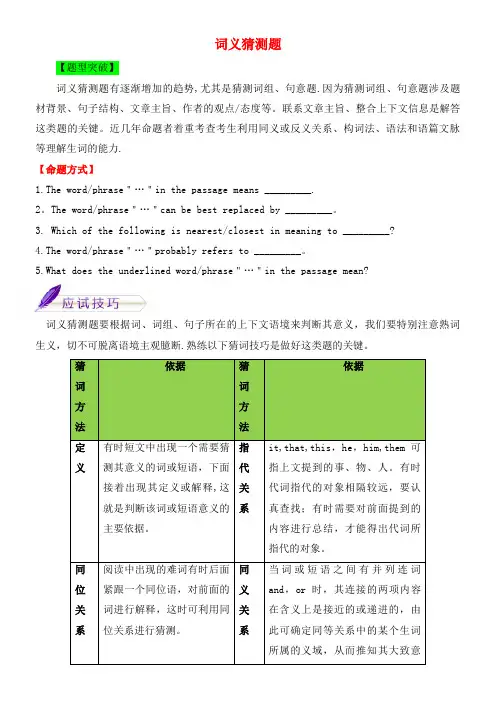
词义猜测题【题型突破】词义猜测题有逐渐增加的趋势,尤其是猜测词组、句意题.因为猜测词组、句意题涉及题材背景、句子结构、文章主旨、作者的观点/态度等。
联系文章主旨、整合上下文信息是解答这类题的关键。
近几年命题者着重考查考生利用同义或反义关系、构词法、语法和语篇文脉等理解生词的能力.【命题方式】1.The word/phrase"…"in the passage means _________.2。
The word/phrase"…"can be best replaced by _________。
3. Which of the following is nearest/closest in meaning to _________?4.The word/phrase"…"probably refers to _________。
5.What does the underlined word/phrase"…"in the passage mean?词义猜测题要根据词、词组、句子所在的上下文语境来判断其意义,我们要特别注意熟词生义,切不可脱离语境主观臆断.熟练以下猜词技巧是做好这类题的关键。
猜词方法依据猜词方法依据定义有时短文中出现一个需要猜测其意义的词或短语,下面接着出现其定义或解释,这就是判断该词或短语意义的主要依据。
指代关系it,that,this,he,him,them可指上文提到的事、物、人。
有时代词指代的对象相隔较远,要认真查找;有时需要对前面提到的内容进行总结,才能得出代词所指代的对象。
同位关系阅读中出现的难词有时后面紧跟一个同位语,对前面的词进行解释,这时可利用同位关系进行猜测。
同义关系当词或短语之间有并列连词and,or时,其连接的两项内容在含义上是接近的或递进的,由此可确定同等关系中的某个生词所属的义域,从而推知其大致意Passage1(2017·新课标卷I ,D )drinking water in areas where the liquid is not readily available. Developed by two doctors in the U 。
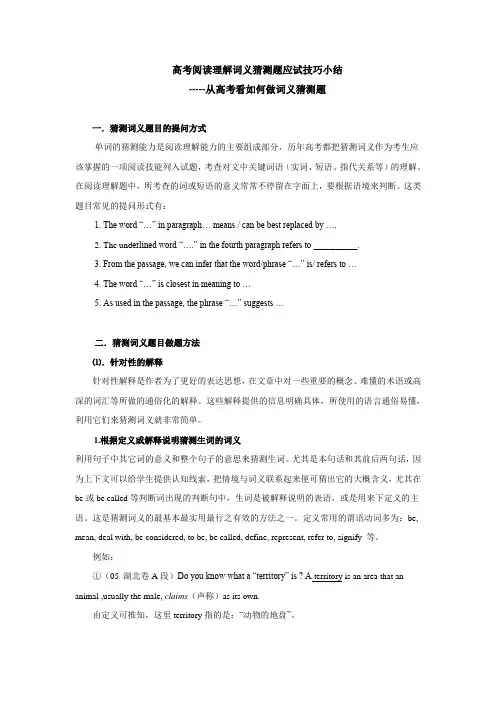
高考阅读理解词义猜测题应试技巧小结-----从高考看如何做词义猜测题一.猜测词义题目的提问方式单词的猜测能力是阅读理解能力的主要组成部分,历年高考都把猜测词义作为考生应该掌握的一项阅读技能列入试题,考查对文中关键词语(实词、短语、指代关系等)的理解。
在阅读理解题中,所考查的词或短语的意义常常不停留在字面上,要根据语境来判断。
这类题目常见的提问形式有:1. The word “…” in paragraph… means / can be best replaced by ….2. The und erlined word “….” in the fourth paragraph refers to __________.3. From the passage, we can infer that the word/phrase “…” is/ refers to …4. The word “…” is closest in meaning to …5. As used in the passage, the phrase “…” suggests …二.猜测词义题目做题方法⑴.针对性的解释针对性解释是作者为了更好的表达思想,在文章中对一些重要的概念、难懂的术语或高深的词汇等所做的通俗化的解释。
这些解释提供的信息明确具体,所使用的语言通俗易懂,利用它们来猜测词义就非常简单。
1.根据定义或解释说明猜测生词的词义利用句子中其它词的意义和整个句子的意思来猜测生词。
尤其是本句话和其前后两句话,因为上下文可以给学生提供认知线索,把情境与词义联系起来便可猜出它的大概含义,尤其在be或be called等判断词出现的判断句中,生词是被解释说明的表语,或是用来下定义的主语。
这是猜测词义的最基本最实用最行之有效的方法之一。
定义常用的谓语动词多为:be, mean, deal with, be considered, to be, be called, define, represent, refer to, signify 等。

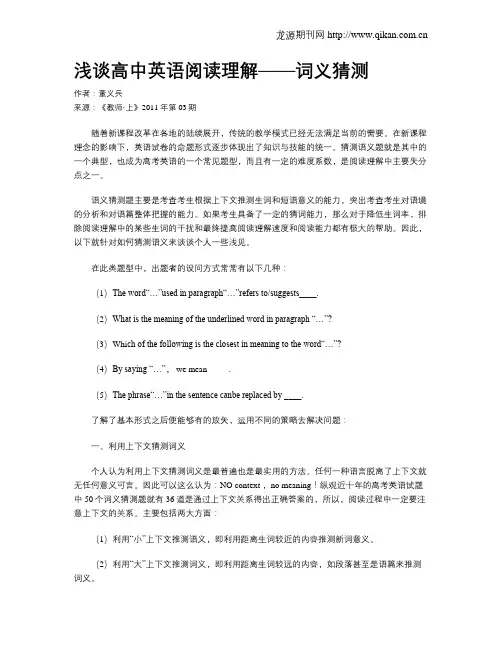
浅谈高中英语阅读理解——词义猜测作者:董义兵来源:《教师·上》2011年第03期随着新课程改革在各地的陆续展开,传统的教学模式已经无法满足当前的需要。
在新课程理念的影响下,英语试卷的命题形式逐步体现出了知识与技能的统一。
猜测语义题就是其中的一个典型,也成为高考英语的一个常见题型,而且有一定的难度系数,是阅读理解中主要失分点之一。
语义猜测题主要是考查考生根据上下文推测生词和短语意义的能力,突出考查考生对语境的分析和对语篇整体把握的能力。
如果考生具备了一定的猜词能力,那么对于降低生词率,排除阅读理解中的某些生词的干扰和最终提高阅读理解速度和阅读能力都有极大的帮助。
因此,以下就针对如何猜测语义来谈谈个人一些浅见。
在此类题型中,出题者的设问方式常常有以下几种:(1)The word“…”used in paragraph“…”refers to/suggests____.(2)What is the meaning of the underlined word in paragraph “…”?(3)Whi ch of the following is the closest in meaning to the word“…”?(4)By saying “…”, we mean_____.(5)The phrase“…”in the sentence canbe replaced by ____.了解了基本形式之后便能够有的放矢,运用不同的策略去解决问题:一、利用上下文猜测词义个人认为利用上下文猜测词义是最普遍也是最实用的方法。
任何一种语言脱离了上下文就无任何意义可言。
因此可以这么认为:NO context ,no meaning!纵观近十年的高考英语试题中50个词义猜测题就有36道是通过上下文关系得出正确答案的,所以,阅读过程中一定要注意上下文的关系。
主要包括两大方面:(1)利用“小”上下文推测语义,即利用距离生词较近的内容推测新词意义。
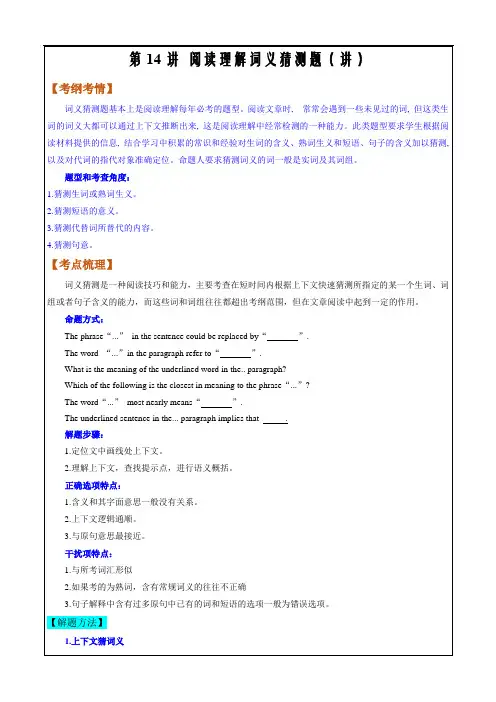
第14讲阅读理解词义猜测题(讲)【考纲考情】词义猜测题基本上是阅读理解每年必考的题型。
阅读文章时, 常常会遇到一些未见过的词, 但这类生词的词义大都可以通过上下文推断出来, 这是阅读理解中经常检测的一种能力。
此类题型要求学生根据阅读材料提供的信息, 结合学习中积累的常识和经验对生词的含义、熟词生义和短语、句子的含义加以猜测, 以及对代词的指代对象准确定位。
命题人要求猜测词义的词一般是实词及其词组。
題型和考查角度:1.猜测生词或熟词生义。
2.猜测短语的意义。
3.猜测代替词所替代的内容。
4.猜测句意。
【考点梳理】词义猜测是一种阅读技巧和能力,主要考查在短时间内根据上下文快速猜测所指定的某一个生词、词组或者句子含义的能力,而这些词和词组往往都超出考纲范围,但在文章阅读中起到一定的作用。
命题方式:The phrase“...”in the sentence could be replaced by“”.The word “...”in the paragraph refer to“”.What is the meaning of the underlined word in the.. paragraph?Which of the following is the closest in meaning to the phrase“...”?The word“...”most nearly means“”.The underlined sentence in the... paragraph implies that .解题步骤:1.定位文中画线处上下文。
2.理解上下文,查找提示点,进行语义概括。
正确选项特点:1.含义和其字面意思一般没有关系。
2.上下文逻辑通顺。
3.与原句意思最接近。
干扰项特点:1.与所考词汇形似2.如果考的为熟词,含有常规词义的往往不正确3.句子解释中含有过多原句中已有的词和短语的选项一般为错误选项。

(教师版)一、目标预设通过本节课学习,提高学生阅读理解猜测词义的解题能力。
二、知识梳理(一)猜测词义常用的十种方法在阅读中,我们会经常遇到一些生词,需要根据上下文猜测它们的词义。
此类问题考查考生紧扣原文,根据上下文语境判断单词、短语或短句意义的能力。
1.根据定义或解释猜测词义这类定义或解释通常由生词后的同位语(从句)或定语从句引出。
例:The modern age of medicine began with the stethoscope, an instrument for listening to a patient’s heartbeat and breathing.析:同位语意思是,stethoscope是用来听病人心脏跳动和呼吸的仪器,即“听诊器”。
2.根据对比关系猜测词义当句中含有but, however, yet, though, although, on the other hand, instead,in contrast等表示转折意义的词时,前后句含有对比意义,据此可以猜测生词的词义。
例:Andrew is one of the most supercilious men I knew. His brother, in contrast, is quite modest.析:in contrast对比之下,supercilious与modest意义相对应,我们便能猜出supercilious 意为“傲慢的;目空一切的”。
3.根据因果关系猜测词义表示因果关系的信息词有:because, so, therefore, thus, so…that等。
例:I found I was paying too much attention to the job and thus sacrificing my study time.析:thus是信息词,因为我对工作过分注意,因此失去了许多学习的时间,这样就得知sacrifice意为“牺牲;失去”。
高考阅读理解词义猜测题解题技巧猜词悟义是应用英语的重要能力,也是高考阅读理解中必考的题型。
它不但需要准确无误地理解上下文,而且要有较大的泛读量,掌握或认识较多的课外词汇。
考生应学会通过构词、定义、同位、对比、因果、常识、同义、反义及上下文线索等确定词义。
一、题型特点与命题方式猜测词义题是近年来高考阅读理解中比较常见的题型,通常在一套试题中会有两到三个小题是直接考查词义猜测的。
这种题型主要是考查考生根据上下文推测生词和短语的能力,突出考查考生对语境的分析和把握能力。
如果我们具备了一定的猜测技巧和猜词能力,我们就能降低生词率,排除阅读理解中某些生词的干扰,最终提高阅读理解速度和能力。
【命题趋势】1、要求根据阅读材料所提供的信息,结合中学生应有的常识和经验,正确判断生词词组的含义或成熟词在特定语境中表达的具体含义以及一些句子的意思。
2、要求猜测词义的词一般为实词及其词组,通过构词、定义、对比、因果、联想、上下文等线索确定词义的具体内容。
3、代词复指理解题也是猜测词义的常考类型。
用―逻辑关系梳理法‖、―递向寻踪法‖理清人物及事物之间的逻辑关系是关键所在。
【设问形式】The underlined wo rd ―…‖ in the second(third…) paragraph refers to(means) ______.By saying ―…‖ in the first(second…) paragraph, the author means that ______.The meaning of ―…‖ in paragraph… is related to ______.Which of the following has the closest meaning to…(paragraph…)?The underlined sentence in the … paragraph probably means that _____.Which of the following words can take the place of the word"..."?What is the meaning of"..."as the words are used in the text?Which of the following has the closest meaning to...(paragraph...)?According to the passage, the word ―…‖ properly means _____.The word ...could best be replaced by____.二、解题思路与应试技巧做这种类型的题,要根据词、词组、句子所在的语境上下文来判断其意义。
学员编号:年级:课时数:学员姓名:辅导科目:英语学科教师:授课类型T C T 阅读猜测词义能力教学目标通过本节了解和熟悉猜测词义的几种技巧星级★★★★授课日期及时段教学内容能力T-猜测词义(建议3 分钟)⏹green hand⏹lady bird⏹big potato⏹john看到上面几个词组了吗,你知道他们分别是什么意思吗?真的如图片所示吗?(建议20 分钟)巧猜词义技巧大突破一、考察形式猜测词义的能力属于英语的基本能力之一。
具体到考试题型上,在单项选择、完型填空、首字母填空、阅读理解等题型上都会有体现,尤其是阅读类题目,对陌生单词意思的猜测和对熟词生义的理解都是会直接影响到对文章的理解。
阅读理解题型往往会以如下形式进行考察。
1.What does the word “…” refer to?2.The underlin ed word “…” is the closest in meaning to ______.3.By saying that“…”, the author means that ___.看到这样的题目,就知道,若是不能理解所指单词意思,那就是失分喽!二、猜词方法大突破前面一开始我们猜测了几个单词的意思,现在我们在有上下文语境的情况下,你猜的对不对。
⏹On the way to the factory, Jack sang a pop song happily. Because it is the first day for him to work,When he was working, he talked with his comrade. Suddenly, the machine broke down because of his carelessness. Jack was afraid of the blame of his boss. His comrade told him, “Take it easy, you are a green hand.”⏹Do you like a lady bird? It is not a kind of bird. It is a insect(昆虫). It can fly. Its wings are red. It is verysmall.⏹Tom is a great man. Tom is treated as a big potato.⏹Tim drank too much water last night, so he went to visit john twice.【讲解】一个完全陌生的单词,或者一个熟悉的单词怎么都看不出啥意思?为什么?缺乏上下文的语境,一个单词,尤其是在文章中出现的单词,其前后句子或单词在意义上和语法上都会与其相联系。
阅读理解题型专讲专练之三:【词义猜测题】常见的解题方法:(一)上下文线索猜测词义任何一篇文章中的句子在内容上都不是绝对孤立的,都跟句子所在的段落及整篇文章有关。
利用上下文提供的情景和线索,进行合乎逻辑的综合分析而推测词义,是阅读过程中的一大关键,也是高考的热点。
如:If he thinks he can invite me out, he is all wet. I don’t like to be with him.A. drunkB. sweatingC. happyD. mistaken(1)The climate of the west coast is the most moderate ( )in Canada, summers are cool and fairly dry and winters are mild, cloudy and wet. Even in mid-winter, the temperature is usually above freezing.(2)All the houses in the city collapsed ( ) during the earthquake.(3)For people who live within a stone’s throw ( ) from the office to be late to work is unforgivable(4)The conflagration( ) was so fierce that with just a few second one could see towering flames where the house had stood and the smoke which filled the sky could be seen for miles and miles.(二)根据定义或解释猜测词义阅读文章中的有些生词尤其是新闻报导及科普类文章中的生词,往往在其后有对该词进行解释说明性的短语或句子,如to be, that is , mean, stand for, namely, refer to, to mean ,in other words等,有时也以同位语、定语从句的形式出现,或用破折号、括号来表示。
专项复习三阅读理解之词义猜测一、考试要求:词义猜测是应用英语的重要能力,也是高考阅读理解中必考的题型。
同学们应通过本专题巩固并加强训练通过构词、定义、同位、对比、因果、常识、同义、反义及语境等确定词义的技能。
五年高考全国卷猜测词义题量统计类别题数考点2006 2007 2008 I 2008 II 2009 I 2009II 2010I 2010II 20 25 20 25 20 25 20 20冠词 2 1 1 1 2 1 1 1二、词义猜测命题特点和趋势:命题者着重考查考生利用同义或反义关系、构词法、语法和语篇文脉等理解生词的能力。
1. 要求根据阅读材料所提供信息,结合高中生应有的常识和经验,正确判断生词、词组的含义或成熟词在特定语境中表达的具体含义以及一些句子的意思。
2. 代词复指理解题也是猜测词义的常考类型。
用“逻辑关系梳理法”、逆向寻踪法”理清人物及事物之间的逻辑关系是关键所在。
【设问形式】The underlined word “…” in the second (third…) paragraph refers to (means) ______.By saying “…” in the firs (second…) paragraph, the author means that ______.In paragraph …, “…” can be replaced by “______”.The meaning of “…” in paragraph… is related to ______.Which of the following has the closest meaning to…(paragraph…)?The underlined sentence in the … paragraph probably means that _____.三、应试策略由于猜测词义题涉及题材背景、句子结构、文章主旨、作者的观点态度等,因此联系主旨、整合上下文信息是解答这类题的关键。
(教师版)一、目标预设通过本节课学习,提高学生阅读理解猜测词义的解题能力。
二、知识梳理(一)猜测词义常用的十种方法在阅读中,我们会经常遇到一些生词,需要根据上下文猜测它们的词义。
此类问题考查考生紧扣原文,根据上下文语境判断单词、短语或短句意义的能力。
1.根据定义或解释猜测词义这类定义或解释通常由生词后的同位语(从句)或定语从句引出。
例:The modern age of medicine began with the stethoscope, an instrument for listening to a patient’s heartbeat and breathing.析:同位语意思是,stethoscope是用来听病人心脏跳动和呼吸的仪器,即“听诊器”。
2.根据对比关系猜测词义当句中含有but, however, yet, though, although, on the other hand, instead,in contrast等表示转折意义的词时,前后句含有对比意义,据此可以猜测生词的词义。
例:Andrew is one of the most supercilious men I knew. His brother, in contrast, is quite modest.析:in contrast对比之下,supercilious与modest意义相对应,我们便能猜出supercilious 意为“傲慢的;目空一切的”。
3.根据因果关系猜测词义表示因果关系的信息词有:because, so, therefore, thus, so…that等。
例:I found I was paying too much attention to the job and thus sacrificing my study time.析:thus是信息词,因为我对工作过分注意,因此失去了许多学习的时间,这样就得知sacrifice意为“牺牲;失去”。
4.根据同等关系猜测词义表示同等关系的信息词有:and, or, or rather, to be more exact, namely, that’s to say,in other words,that is等。
例:His secret for a living and healthy life has been well publicized---no alcohol, no cigarette and no anger.析:由a living and healthy life以及同类名词cigarette可推测alcohol意为“酒精”。
5.根据同义词、近义词或反义词猜测词义这类同义词、近义词或反义词往往有and, or, but, however等信息词作暗示。
例:In our competitive world of today, examinations have a highly selecting or filtering role.析:句中selecting 与filtering含义相近,可由selecting(挑选)推测filtering 意为“筛选;选拔”。
6.根据标点符号猜测词义这类标点符号通常为括号、冒号、破折号、逗号等。
例:You can take any of the periodicals: The World of English, Foreign Language Teaching in School, or English Learning.析:根据冒号后面所举例子可知periodicals意为“magazines published at regular times”,即“期刊”。
7.根据经验或常识猜测词义有时需要根据中学生应具备的基本知识或常识作出合理的推测判断。
例:The heat of sun warms some ocean water. The surface of the water evaporates, forming a cloud of warm, wet air that moves upward.析:结合地理学科中云团的形成过程可知,“海水因受到光照蒸发,水气上升形成暖湿云团”。
由此可知evaporates意为“蒸发”。
8.根据上下文语境猜测词义俗话说,“词不离句,句不离文”。
特定的上下文往往是推测词义不可忽视的重要因素。
例:The pupils assembled in front of the school hall. They came together to listen to the headmaster announce the result of the sports meeting.析:第二句有came together(聚到一起),很明显学生们是“聚集到”学校大厅前听校长宣布运动会的成绩。
9.根据举例、例举猜测词义这类信息词有such as, for example, for instance,say等短语。
例:Today young couples who are just starting their household often spend lots of their money on appliances, for instance, washing-machines, fridges and colour TV sets.析:从for instance后所列举的例子可知,appliances意为“electric equipment used at home”,即“家用电器”。
10.根据构词法猜测词义英语中构词法有三种,即派生、转化和合成。
例:He was performing before a packed home and his technique was unbelievable, his tone was wonderful and his audience deeply loved him.析:unbelievable是由词根believe,前缀un-,后缀-able组成,意为“cannot be believed”,即“难以置信的”(二)高中英语常用前缀、后缀常用前缀1. aero: concerning the air or aircraft plane飞机—aeroplane飞机2. anti: against; opposite of nuclear[核]核子的—antinuclear反对使用核武器的war战争/作战/打仗—antiwar反战的, 反对战争的3. auto: of or by oneself biography传记—autobiography自传4. bi: two; twice; double lingual语言的—bilingual能说两种语言的5. bio: concerning living things chemistry化学—biochemistry生物化学6. by—:less important product产品/产物—by-product副产品/附加产物7. co: together, with author作家/创造者—coauthor合著者/共同执笔者/合著exist 存在/生存—coexist 共存8. contra: opposite diction措辞/用语/言语—contradiction反驳/矛盾natural自然的/自然界的—contranatural违背自然的9. counter: opposite attack 攻击—counterattack反击,反攻10. cross: across; going between the stated things and joining themcountry乡下的/乡村的—cross-country横过田野的11.dis:not; the opposite of advantage优势/有利条—disadvantage不利/不利条件/劣势12. en: to cause to become; to make danger 威胁—endanger危及Large 大的/巨大的—enlarge扩大/放大13. ex: former(and still living) minister部长/大臣—ex-minister 前部长14. extra: outside; beyondordinary平常的/普通的/平凡的—extraordinary非常的/特别的/非凡的15. fore: in advance, before; in or at the frontarm臂/武器/装备—forearm前臂/准备战斗/预先武装/准备16. il: (used before l) not legal法律的/合法—illegal违法的/不合规定的literate学者/有文化的/有阅读写作能力的—illiterate 文盲/文盲的17. im:(used before b,m,p) notmoral道德(上)的/精神的/道德—immoral不道德的/邪恶的/放荡的/淫荡的18. ir:(used before r)not regular规则的/有秩序的—irregular不规则的/无规律的responsible有责任的/可靠的—irresponsible不负责任的/不可靠的19. in: not direct径直的/直接的—indirect间接的/迂回的20. inter: between; among change改变/变化—interchange(指两人等)交换/相互交换national国家的/民族的—international国际的/国际性组织/国际比赛21. macro: large, esp. concerning a whole system rather than particular parts ofeconomics经济学—macroeconomics宏观经济学22. micro: extremely small computer计算机/电脑—microcomputer微型计算机23. tri: three; three times angular有角的—triangular三角形的24. mini: small; short minibus小型公共汽车miniskirt超短裙25. mis: bad or badly; wrong or wrongly misfortune不幸/灾祸misunderstand误解/误会26. post: later than; after war战争/作战/打仗—postwar战后的graduate(大学)毕业生,(使)(大学)毕业—postgraduate研究所学生/研究生/毕业后的27. semi: half; partly semicircle半圆形final决赛—semifinal半决赛28. super: more, larger, greater than usual market市场—supermarket超级市场supernatural 超自然的,超自然物29. un: not uncertain不确定的/靠不住的unfortunate不幸的/使人遗憾的30. under: too little; below sea海洋/大浪—undersea海面下的develop发展/显影—underdevelop(使)发展不完全/(使)显影不足31. ab, abs 离去,离开;分离abnormal 畸形、不正常32.be: 加以…;在;使…; befriend 以朋友相待beside33.centi 百分之一centigrade 百分度的centimeter 厘米34.circum 周围/环绕circumstance 环境/ 情况35.kilo 千kilowatt 千瓦kilogram 千克36.max 最好/最大maximum最大maximize 取…最大值37.mid 中midnight mid-autumni 千分之一millimeter 千分之一米/毫米39.multi 多multinational 多民族的multimedia多媒体40.non 不/非/无nonsense 胡说/废话41.over 上/在上/从上/越过/过度overall 全面的,overdue过期的,overhear 偷听oversea 海外的/外国的overwork 过度劳累42.pre 前/先/预先predict预测presume 假定/推测prewar44.re 反对/相反;再次/重新;向后/回reverse颠倒reaction 反应recall回忆45.uni 一、单一uniform统一的46.vice 副vice-president 副总统常用后缀名词后缀1.ibility 性/力able能...的/能干的—ability能力/才干flexible有弹性的/柔韧的—flexibility弹性/适应性/机动性2. an, ian, arianlibrary(图书馆, 藏书室)—librarian(图书馆员, 图书管理员)music(音乐, 乐曲)—musician(音乐家)3. ance,enceappear(出现, 公开露面)—appearance(出现, 露面, 外貌, 外观)refer(提交, 谈及,提到, 涉及, 查阅, 咨询)—reference提及, 涉及, 参考, 参考书目, 证明书(人), 介绍信(人)4. ancy,ency emerge显现/(事实)显现出来—emergency紧急情况/突然事件5. ant,ent apply(申请)—applicant(申请者, 请求者)6. cy accurate(正确的, 精确的)—accuracy(精确性, 正确度)7. dom king(国王, 君主, (部落的)首领, , 统治)—kingdom(王国, 领域)8. ee employ(雇用, 用)—employee(职工, 雇员, 店员)9.er,or,ar paint(油漆, 颜料)—painter(油漆匠)beg(乞求,)—beggar(乞丐)10. ery brave(勇敢的)—bravery(勇敢)11. ese: China(中国)—Chinese(中国的,)Japan(日本)—Japanese(日本的)12. hood child(孩子,)—childhood(孩童时期)man(男人)—manbood(成年男子)13. ics electron(电子)—electronics(电子器件)14. ism Marx马克思—Marxism马克思主义socialist社会主义者—socialism社会主义15. ist violin(小提琴)—violinist(小提琴演奏者)16. ity,ty cruel(残酷的)—cruelty(残酷)17. ment move(移动, 迁居)—movement(运动, 动作)18. ness dark(黑暗, 夜)—darkness(黑暗, 漆黑)19. ship scholar(学者)—scholarship(奖学金, 学问, 学识)20. sion, ssion decide决定/判决—decision决定/决心expand使膨胀/扩张—expansion扩充/开展21. th grow(生长, 成长)—growth(生长, 种植)22. ure close(关, 关闭)—closure(关闭,使终止)动词后缀23. en deep(深的, 纵深的)—deepen(加深, 深化)24. ify class(班级, 阶级)—classify(分类, 分等)simple(简单的, 简易的)—simplify(单一化, 简单化)25. ize, modernize popular(通俗的, 流行的, 受欢迎的)—popularise/popularize形容词后缀26. able, ible question(疑问)—questionable(可疑的)27. al structure(结构, 构造)—structural(结构的, 建筑的)28. an,arian,ian suburb(市郊, 郊区)—suburban(郊外的, 偏远的)29. ant,ent differ(不一致, 不同)—different(不同的)please(满足, 使满足)—pleasant(令人愉快的, 舒适的)30. ary,ory advise(劝告, 忠告, 警告)—advisory(顾问的, 咨询的, 劝告的)31. en gold(黄金, 金币)—golden(金色的)wood(木材)—wooden(木制的)32. free care(烦恼, 忧虑)—carefree(无忧无虑的, 轻松愉快的)duty(义务, 责任, 税)—dutyfree(自由的, 大方的, 免费)33. less hope(希望, 信心)—hopeless(没有希望的, 绝望的)pain(痛苦, 疼, 痛,)—painless(无痛的, 不痛的)34. ful pain(痛苦, 疼)—painful(疼痛的, 使痛苦的)35. ic,ical atom(原子)—atomic(原子的, 原子能的)psychology(心理学, 心理状态)—psychological(心理(上)的)36. ish girl(女孩, 少女)—girlish(少女的, 少女似的(男孩))child(孩子)—childish(孩子气的, 幼稚的)37. ive support(支援,支柱)—supportive(支持的,支援的)三、达标检测1. It will be very hard but also very brittle--- that is, it will break easily.易碎的(同等关系)2. A strict vegetarian is a person who never eats meat in his life. 素食主义者(定义法)3. Some actions are learned, but other actions are innate. 天生的(对比法)4. Some readers try to understand the general idea while others look for specific details.具体的(对比法)5. Anthropologist thought the Indians’culture would be very primitive; however, they foundmany modern elements in the Indian’s lives. 原始的(对比法)6. That museum is so immense that it will be impossible to see all the exhibits in one day.巨大的(因果关系)7.The lack of movement caused the muscles to weaken. Sometimes the weakness waspermanent. So the player could never play the sport again.永恒的(因果关系)8.There are many sources of air pollution; exhaust fumes, for example. 废气(例举法)9.But for the captain’s courage, perseverance, and powerful will, people on board would havedied. 毅力(例举法)10.Each person has a cup and saucer, a spoon and a plate for bread-and-butter breakfast.茶碟(例举法)11.Brazilian government decided to have a new city built 600 miles northwest of Rio de Jaciro,designed by the great architect Lucio Costa.建筑师(上下文语境)12. It was a blue Monday and he just didn’t like going back to work.忧郁的(上下文语境)13.There are also rules which deal with the standard of services you get--- from, say, travelagents, shoe repairers, hairdressers and builders. These tell you what you should expect from any service you pay for. (05湖北C)(代词替代法)64.The underlined wore “these” in Paragraph 2 refers to “____D_____”.A. the servicesB. the workersC. the goodsD. the rules四、巩固训练1.2007江西卷It is obvious that if students value highly their test scores, then a great amount of their self-respect is put in the number. Students who perform poorly on the exam are left feeling that it is all over. The low test score, they think, will make it impossible for them to get into a good college. And without a degree from a prestigious university, they fear that many of life's doors will remain forever closed.66.“A prestigious university”is most probably AA. a famous universityB. a technical universityC. a traditional universityD. an expensive university2. 2008江苏卷Time is something from which we ca n’t escape. Even if we ignore it, it’s still going by, ticking away, second by second, minute by minute, hour by hour. So the main issue in using your time well is, “Who’s in charge?” We can allow time to slip by and let it be our enemy. Or we can take control of it and make it our ally.B__.A. your slave and serves youB. your supporter and helps youC. under your control and obeys youD. under your influence and follows you3.2008辽宁卷Study showed that it is an unusual kind of protein. It has many small sugar molecules (分子) held in special positions within each big protein molecule. Because of its sugar content, it is called a glycoprotein. So it has come to be called the antifreeze fish glycoprotein, or AFGP.What does "glyco-"' in the underlined word "'glycoprotein" in the last paragraph mean? AA. sugarB. iceC. bloodD. Molecule4.2008浙江卷A Brown University sleep researcher has some advice for people who run high schools: Don’t start classesso early in the morning. It may not be that the students who nod off at their desks are lazy. And it may not be that their parents have failed to enforce (确保) bedtime. Instead, it may be that biologically these sleepyhead students aren’t used to the early hour.49. The underlined phrase “nod off” most probably means “ ___C____”.A. turn aroundB. agree with othersC. fall asleepD. refuse to work5.2008福建卷For years we hav e been told that encouraging a child’s self-respect is important to his or her success in life. But child experts are now learning that too much praise can lead to the opposite effect. Praise-sholic kids who expect it at every turn may become teens who seek to same kind of approval from friends when asked if they want to go in the backseat of the car.61. The underlined words “Praise-sholic kids” refers to kids who are ____D__.A. tired of being praisedB. worthy of being praisedC. very proud of being praisedD. extremely fond of being praised6.2008广东C篇When some kind of pain killer was brought out recently, researchers found that the colours turned the customers off because they made the product look weak and ineffective.65.The underlined part ”the colours turned the customers off ”(in para 3) means that the colours____.CA. attracted the customers stronglyB. had weak effected on the customersC. tricked the customers into shoppingD. caused the customers to lose interest。